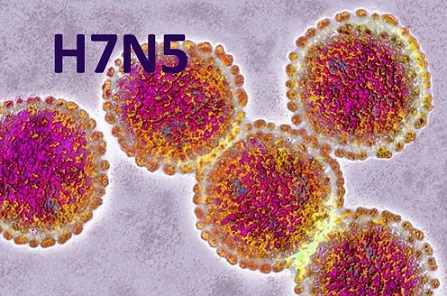Nikhil Prasad Fact checked by:Thailand Medical News Team Jul 05, 2024 9 months, 3 weeks, 7 hours, 39 minutes ago
Influenza News: A New Strain Emerges
In a surprising development, Germany has reported a rare outbreak of highly pathogenic H7N5 bird flu on a farm in the western part of the country, close to the Dutch border. This marks the first documented case of H7N5 in the World Organization for Animal Health's (WOAH) records, which date back to 2005. The outbreak occurred in Bad Bentheim, Lower Saxony, resulting in the death of 6,000 birds out of a flock of 90,879.
 H7N5 Debuts In Germany To Cause Bird Flu Outbreak Near Border With Netherlands
Discovery and Confirmation
H7N5 Debuts In Germany To Cause Bird Flu Outbreak Near Border With Netherlands
Discovery and Confirmation
The outbreak was first detected on June 29 and confirmed on July 2, according to a report from German authorities. WOAH, based in Paris, highlighted this unprecedented event, noting the significance of the new H7N5 strain, which differs from the more familiar H5N1 strain. While H5N1 has decimated bird flocks and even spread to mammals and some humans globally, H7N5 had not previously been recorded in WOAH's public records.
Context of Recent Avian Influenza Cases
In recent months, Germany has been grappling with various avian influenza cases. According to local
Influenza News coverages, these outbreaks have affected turkey flocks, layer flocks, and backyard chickens across the country. Notably, of the 63 cases detected in wild birds, 44 were in the northern state of Schleswig-Holstein, with the remainder spread across seven other states. Two of these cases were confirmed to be the H5N5 virus serotype, while the others were identified as H5N1.
National Disease Risk Assessment
The Friedrich-Loeffler Institute (FLI), Germany's veterinary reference laboratory, has maintained a "high" level of national disease risk assessment due to the ongoing trends in avian influenza. The assessment takes into account the significant impact of avian influenza across Europe, where six million poultry have been lost to the disease since last autumn. Furthermore, infections have been confirmed in various wild bird species, particularly waterfowl near the North Sea and the Baltic Sea.
Implications and Future Measures
The emergence of H7N5 adds a new layer of complexity to the ongoing battle against avian influenza. German authorities are closely monitoring the situation, implementing stringent measures to prevent further spread. The unprecedented nature of this outbreak necessitates a reevaluation of current surveillance and biosecurity practices to better understand and mitigate the risks associated with this new strain.
Avian Influenza A(H7) Viruses: An Overview
Avian influenza A(H7) viruses encompass nine known subtypes: A(H7N1), A(H7N2), A(H7N3), A(H7N4), A(H7N5), A(H7N6), A(H7N7), A(H7N8), and A(H7N9). These subtypes are typically classified as low pathogenic avian influenza (LPAI) viruses when identified in wild birds and poultry around the world.
ex.html">https://www.cdc.gov/bird-flu/about/index.html
Human Infections and Their Impacts
Human infections with avian influenza A(H7) viruses are rare but have occurred sporadically. Among these, the A(H7N9) virus, first identified in China in 2013, is the most frequently associated with human cases. Although infections with A(H7N9) are uncommon, they have led to severe respiratory illness and have had a fatality rate of approximately 40% in reported instances.
Other A(H7) Subtypes and Human Health
Apart from A(H7N9), there have been reports of human infections with several other A(H7) subtypes, including A(H7N2), A(H7N3), A(H7N4), and A(H7N7). These infections have generally resulted in mild to moderate illness, with symptoms often manifesting as conjunctivitis or upper respiratory tract issues. Despite the generally less severe nature of these cases compared to A(H7N9), vigilance and monitoring remain essential to prevent and manage potential outbreaks.
Conclusion
The rare outbreak of H7N5 bird flu in Germany underscores the ever-evolving challenges posed by avian influenza. As authorities work to contain this new strain, the incident serves as a reminder of the importance of vigilance and preparedness in managing animal health crises. Continued research and collaboration at both national and international levels will be crucial in addressing the threats posed by emerging infectious diseases.
For the latest
Influenza News, keep on logging to Thailand Medical News.
Read Also:
https://www.thailandmedical.news/news/colorado-reports-male-infected-with-h5n1-from-dairy-cattle-fourth-case-in-united-states-more-cases-expected
https://www.thailandmedical.news/news/traditional-chinese-medicine-s-rujin-jiedu-decoction-a-new-hope-for-influenza
